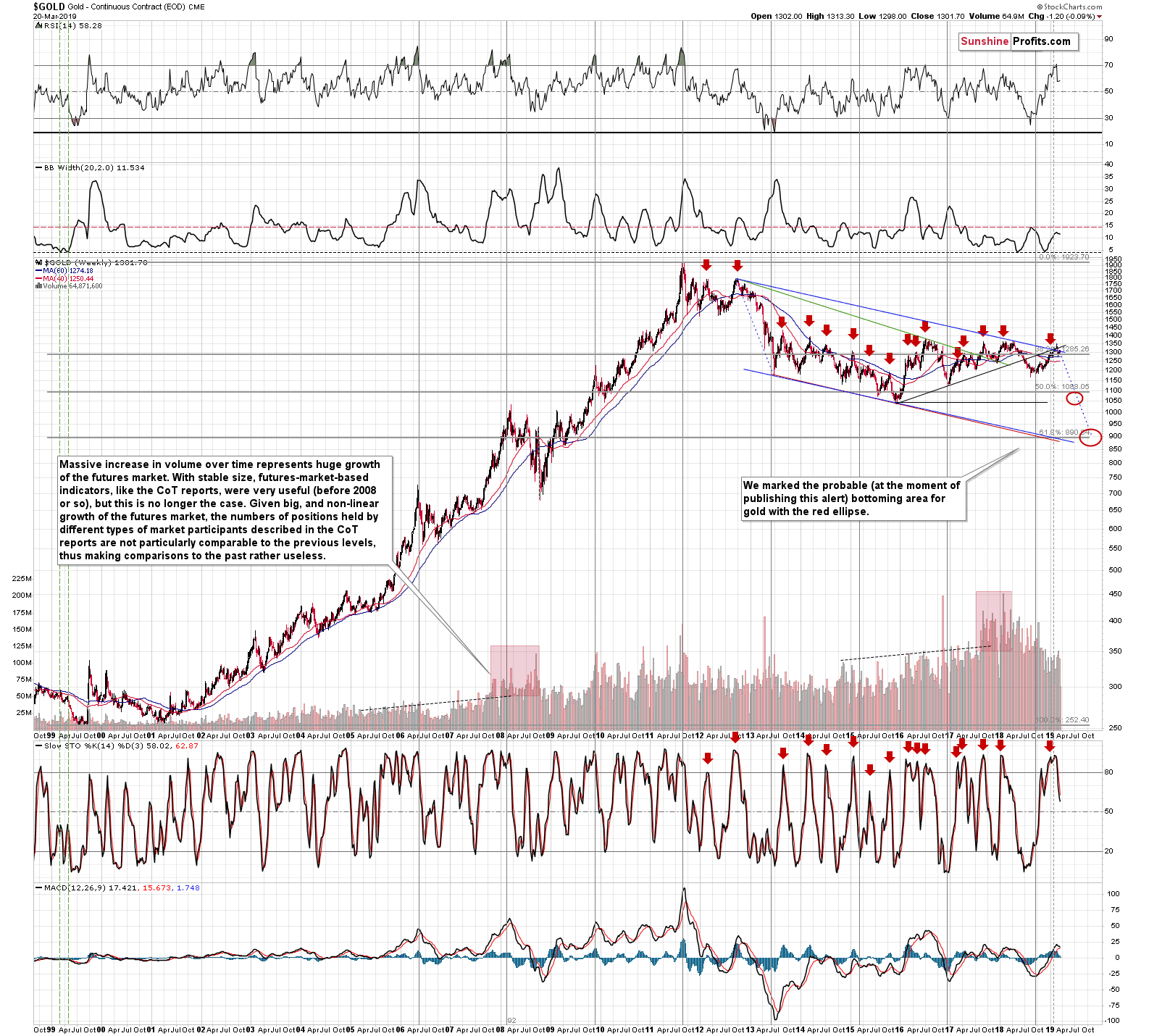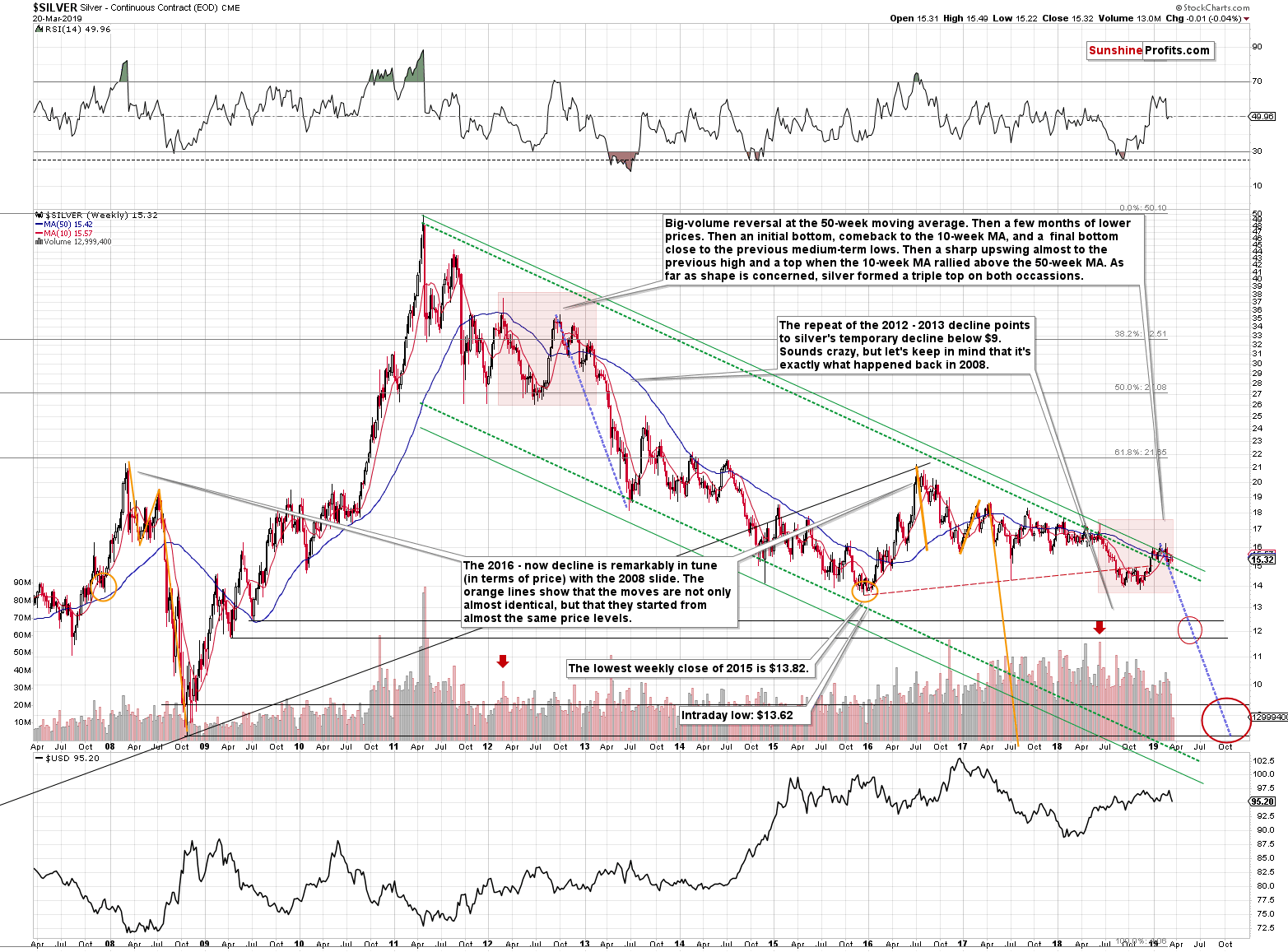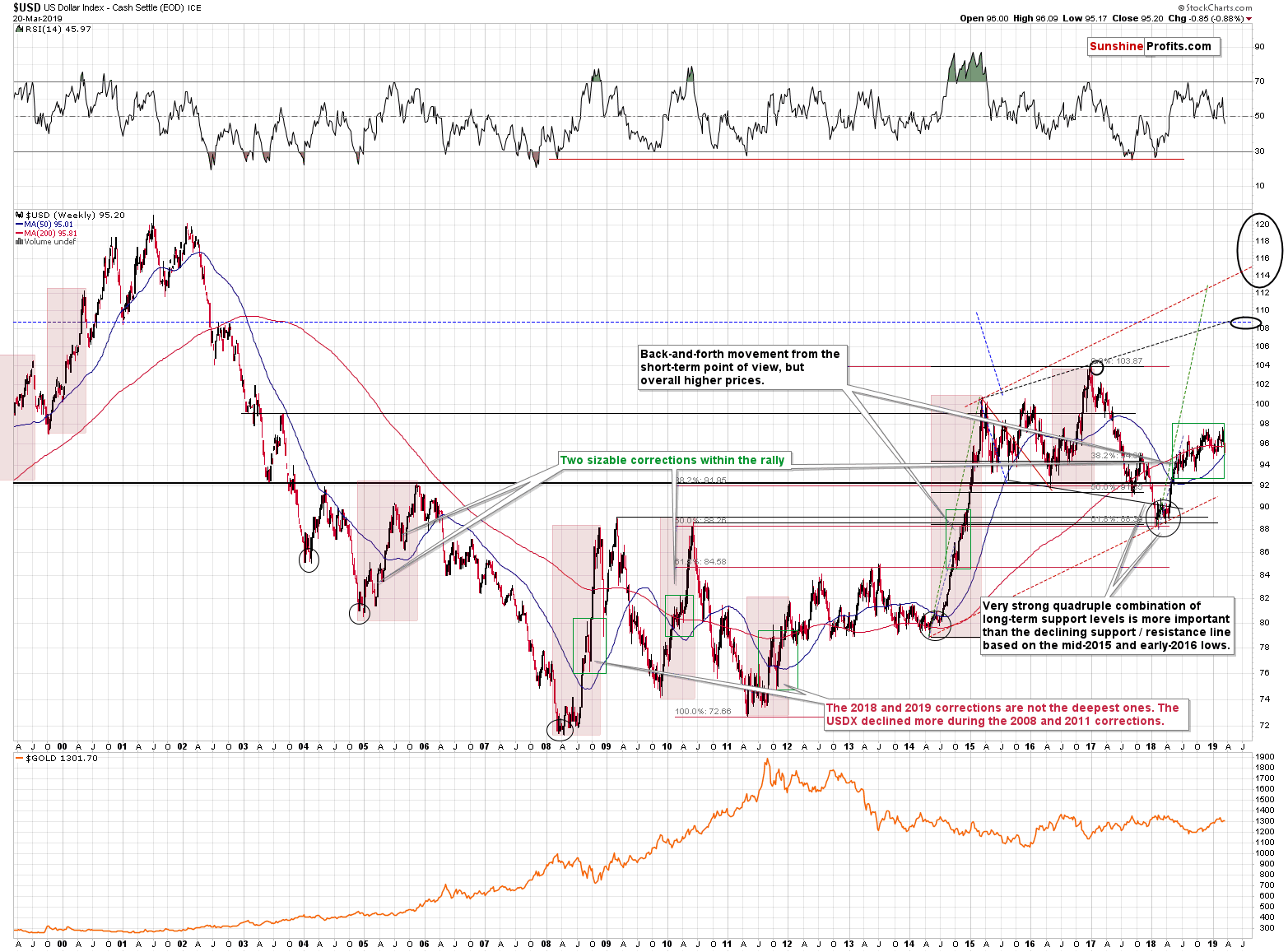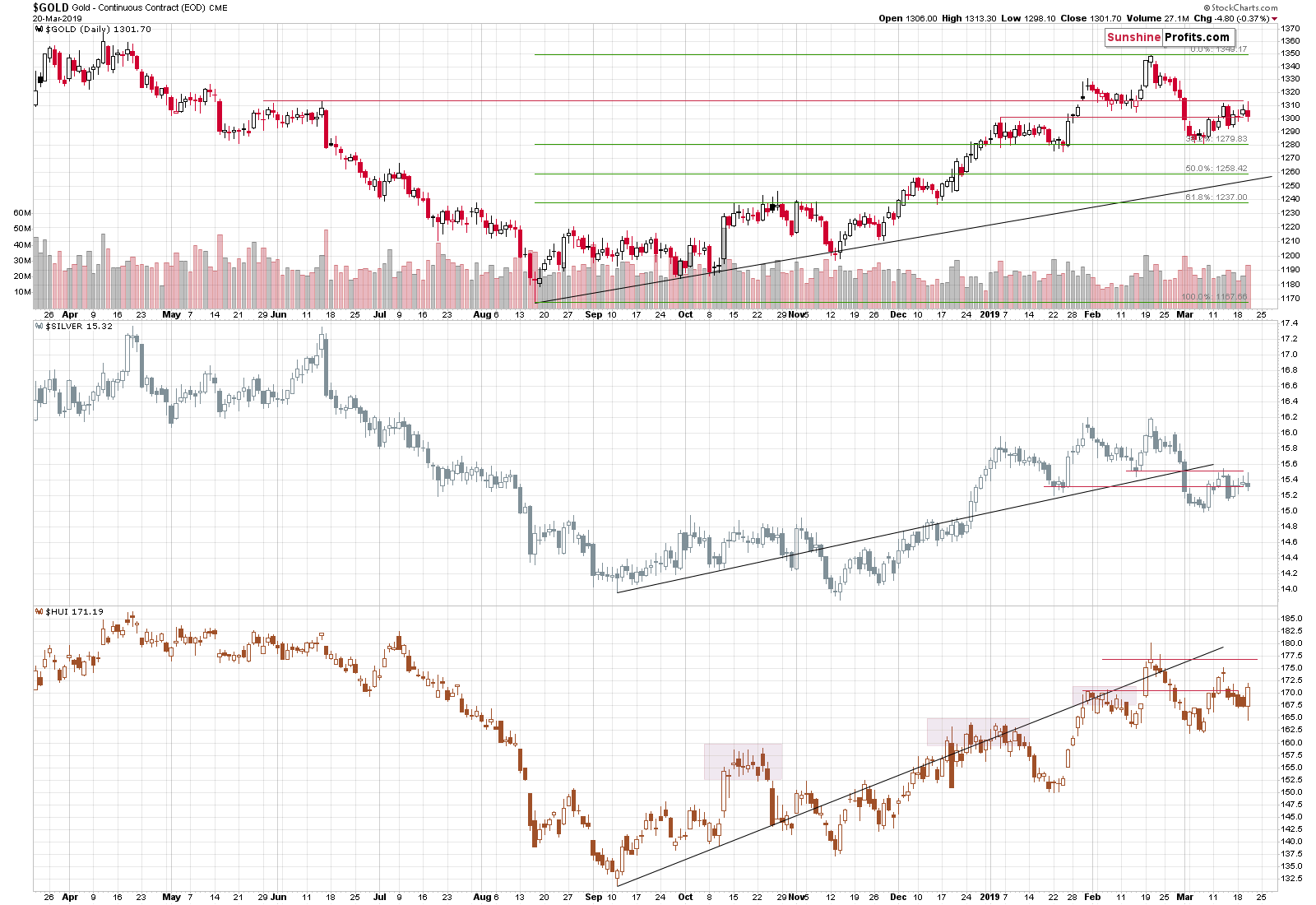Briefly: in our opinion, full (250% of the regular size of the position) speculative short position in gold, silver, and mining stocks is justified from the risk/reward perspective at the moment of publishing this Alert.
Gold has gained based on the Fed’s U-turn yesterday. The $64,000 question is: how high has it actually risen vs. how high could (should) it have risen? The market seems to have been caught off guard by the deep change to the interest rate hike projections in the Fed’s dot plot and the announced balance sheet reduction tapering in May followed by stopping them entirely before September is over. In today’s Alert, we explore how yesterday’s events fit into the political, economic and intermarket analysis. Based on these, we’ll present our conclusions about how they affect the current market standing and prospects for the precious metals going forward.
Yesterday, the Fed shocked the markets with a very dovish approach despite earlier hawkish tone. Is the Fed really as data-driven as it wants everyone to believe? Or are the decisions political after all and aimed at preventing stock markets’ and… euro’s collapse? It’s really hard to believe that the Fed has really been following the data, and that the change in its approach has nothing to do with the short-term stock market performance and political tensions. Nothing really changed in the economic indicators, and yet the last couple of months saw a complete change in Fed’s approach. While the goal of preventing stock market’s collapse may seem believable, why would the Fed be concerned with preventing euro’s demise?
One thing might be some unofficial talks between the Fed and ECB, and another factor would be the problematic consequences of very strong dollar that would hurt the US exports. The latter is nothing new – no country wants to have a very strong currency nowadays, so it might actually be the former that is really responsible for the change. You see, the ECB recently became more dovish and the euro tumbled. It’s after a prolonged consolidation, so a breakdown below it, is likely to result in a powerful slide (and a rally in the USDX) and the Powers That Be know it. Perhaps the situation in the Eurozone is much worse than what is officially reported? If so, then the outlook for gold is excellent in the long run, but gold is likely to suffer in the medium term (which is exactly what our chart analysis suggests). Why? Because when people want to get out of the euro, they will first focus on the US dollar, not on gold. As the USD soars, gold would likely tumble – at least initially.
The quick change in the Fed’s approach has likely raised quite a few eyebrows among investors and many of them will question the validity of this decision. And as this process becomes more intense, the USD is likely to rally anyway. Markets are forward-looking - people expecting the USD to move higher based on future Eurozone trouble will buy US dollars now and contribute to higher prices right away.
Of course, not everyone will do so, but as the trend gradually catches on, the USD will be more and more reluctant to decline on bearish news and will soar on bullish ones. That’s exactly what we seem to be seeing from the long-term point of view. Not yesterday, but when the Fed previously surprised the markets with dovish remarks, the negative reaction was very short-lived. We are likely to see something similar shortly and when we do, it will serve as an indication that the above hypothesis may be quite close to reality.
The precious metals’ reaction to yesterday’s shocker was also quite informative. Quoting our yesterday’s intraday Alert:
No hikes this year and only one in 2020. In light of the above decision there is now very little the Fed can reasonably do to generate another bullish response in the precious metals sector. It’s close to being out of bullets. Technically, it could start lowering the rates, launch more money-printing mechanisms (QE and similar), but given all the narration about stronger economy, rising - on average - stock market, it’s extremely unlikely in the next several months. This means that there’s very little that the Fed can do to help gold move higher. Therefore, when the decline resumes (and based on the “strength” of today’s move up it seems that it’s going to take place shortly), one shouldn’t count on any meaningful help from the Fed.
Overall, even though gold moved a bit (yes, a bit, because that’s not even a $10 rally so far and we should have seen a massive upswing given Fed’s surprisingly dovish comments), the implications of today’s session are actually bearish for gold as they show just how weak the precious metals market currently is.
The implications are indeed bearish, and the charts below will show you just how tiny the reaction really was.
The Barely Visible Gold and Silver Reaction
Can you see gold’s and silver’s reaction to a dramatic turn to more dovish Fed? You can’t – it’s too tiny to be visible from the long-term point of view. To be honest, the Stockcharts’ closing prices for yesterday’s session seem a bit off, but the intraday highs appear correct – and they should be visible on the above charts. And they’re not, so our point remains valid – the moves were so small that they were practically not visible.
What About the USD?
What about the US dollar? Did it decline profoundly? At the first, day-to-day sight – yes, but what about the big picture? The USD Index didn’t even decline a full index point this week! Dramatic change in the Fed’s approach and the US currency hasn’t lost even 1% of this value relative to other currencies? Of course, the following days might bring more declines, but at this time, it’s more likely that the decline will be short-lived, just like the previous ones.
Putting It All Into Proper Perspective
Gold, silver and miners moved higher yesterday, but there was no major breakout. Gold miners didn’t even move to their previous March highs. If we didn’t know that there was a major news announcement from the Fed, we wouldn’t be able to tell that based on the above chart alone. Yesterday’s session doesn’t differ much from the regular daily technical upswings.
Gold and silver moved up by $6 and $0.13 respectively in today’s pre-market trading (at the moment of writing these words) and even combining the above with what we saw yesterday doesn’t provide us with a really meaningful reaction. Gold miners might move to the March highs based on the above-mentioned upswing in gold and silver and it will be no sign of real strength. Think about it – the most powerful monetary officials in the world just dramatically changed their course, and all miners might to is to move back to their recent highs – that would be a very weak reaction, not a sign of strength or anything bullish.
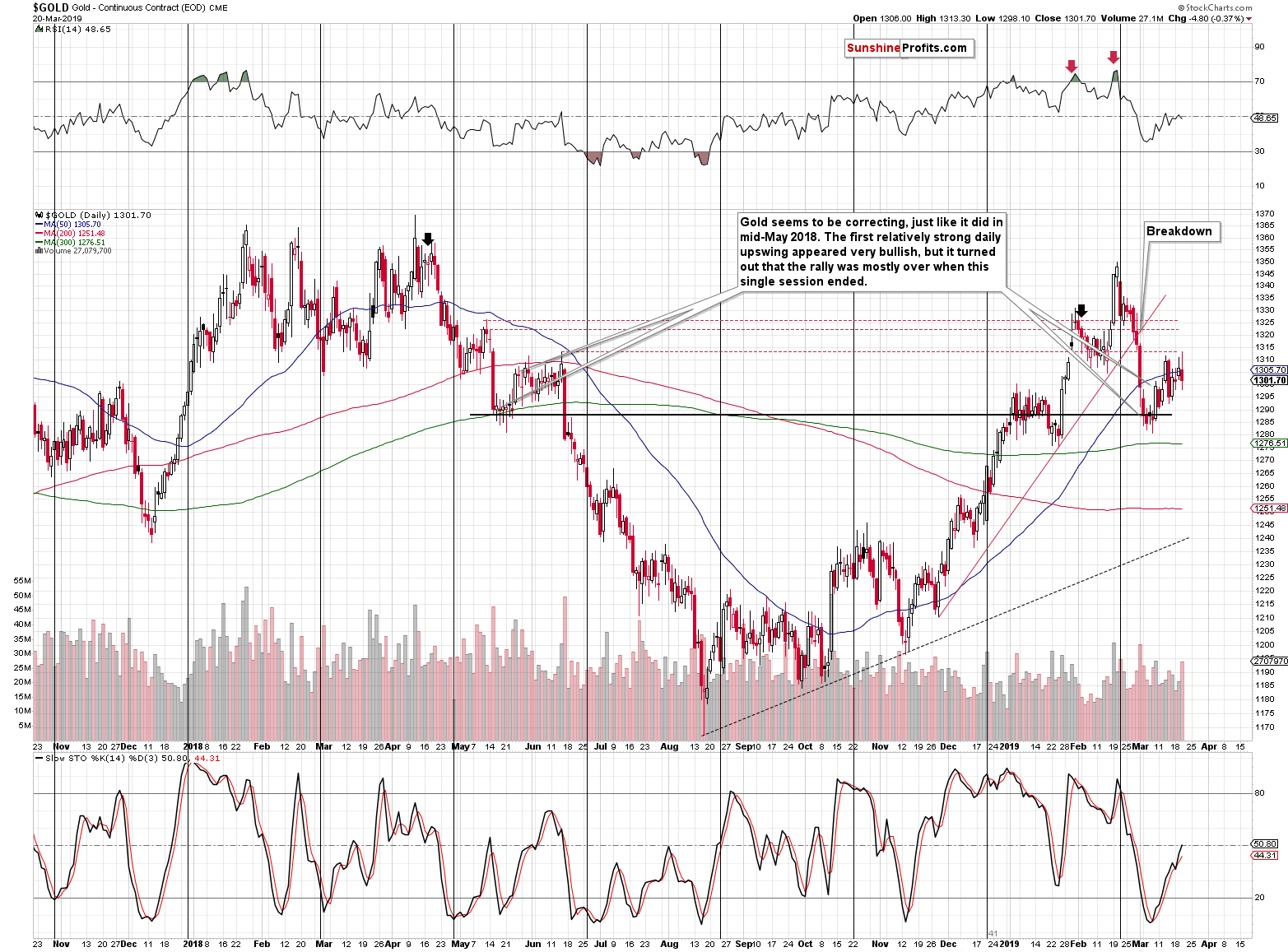
Interestingly, when gold moved below $1,300 in May 2018, it then consolidated for a few weeks before declining once again and we are seeing the same thing right now. In May 2018, there was first an initial high, a move lower and then the final high – only a bit above the previous one. This was the final top after which gold declined. The similarity to today’s situation suggests that a downturn is just around the corner.
Summary
Summing up, it’s almost certain that the next big move lower has already begun and that the 2013-like slide is in its early stage. Based on the updated version of the 2013-now link, the implications are even more bearish than we had initially assumed. The downside target for gold remains intact ($890), and the corrective upswing that we just saw seems to be rather natural part of the bigger move lower – not a beginning of an important move higher. And it seems that the corrective move higher in the PMs is either over or about to be over shortly. Gold’s very weak reaction to Fed’s surprisingly dovish remarks strongly confirms the bearish outlook for the following weeks.
To summarize:
Trading capital (supplementary part of the portfolio; our opinion): Full short position (250% of the full position) in gold, silver, and mining stocks is justified from the risk/reward perspective with the following stop-loss orders and exit profit-take price levels:
- Gold: profit-take exit price: $1,062; stop-loss: $1,357; initial target price for the DGLD ETN: $82.96; stop-loss for the DGLD ETN $39.87
- Silver: profit-take exit price: $12.32; stop-loss: $16.44; initial target price for the DSLV ETN: $47.67; stop-loss for the DSLV ETN $23.68
- Mining stocks (price levels for the GDX ETF): profit-take exit price: $13.12; stop-loss: $24.17; initial target price for the DUST ETF: $76.87; stop-loss for the DUST ETF $15.47
Note: the above is a specific preparation for a possible sudden price drop, it does not reflect the most likely outcome. You will find a more detailed explanation in our August 1st Alert. In case one wants to bet on junior mining stocks’ prices (we do not suggest doing so – we think senior mining stocks are more predictable in the case of short-term trades – if one wants to do it anyway, we provide the details), here are the stop-loss details and target prices:
- GDXJ ETF: profit-take exit price: $17.52; stop-loss: $35.67
- JDST ETF: initial target price: $143.87 stop-loss: $30.97
Long-term capital (core part of the portfolio; our opinion): No positions (in other words: cash)
Insurance capital (core part of the portfolio; our opinion): Full position
Important Details for New Subscribers
Whether you already subscribed or not, we encourage you to find out how to make the most of our alerts and read our replies to the most common alert-and-gold-trading-related-questions.
Please note that the in the trading section we describe the situation for the day that the alert is posted. In other words, it we are writing about a speculative position, it means that it is up-to-date on the day it was posted. We are also featuring the initial target prices, so that you can decide whether keeping a position on a given day is something that is in tune with your approach (some moves are too small for medium-term traders and some might appear too big for day-traders).
Plus, you might want to read why our stop-loss orders are usually relatively far from the current price.
Please note that a full position doesn’t mean using all of the capital for a given trade. You will find details on our thoughts on gold portfolio structuring in the Key Insights section on our website.
As a reminder – “initial target price” means exactly that – an “initial” one, it’s not a price level at which we suggest closing positions. If this becomes the case (like it did in the previous trade) we will refer to these levels as levels of exit orders (exactly as we’ve done previously). Stop-loss levels, however, are naturally not “initial”, but something that, in our opinion, might be entered as an order.
Since it is impossible to synchronize target prices and stop-loss levels for all the ETFs and ETNs with the main markets that we provide these levels for (gold, silver and mining stocks – the GDX ETF), the stop-loss levels and target prices for other ETNs and ETF (among other: UGLD, DGLD, USLV, DSLV, NUGT, DUST, JNUG, JDST) are provided as supplementary, and not as “final”. This means that if a stop-loss or a target level is reached for any of the “additional instruments” (DGLD for instance), but not for the “main instrument” (gold in this case), we will view positions in both gold and DGLD as still open and the stop-loss for DGLD would have to be moved lower. On the other hand, if gold moves to a stop-loss level but DGLD doesn’t, then we will view both positions (in gold and DGLD) as closed. In other words, since it’s not possible to be 100% certain that each related instrument moves to a given level when the underlying instrument does, we can’t provide levels that would be binding. The levels that we do provide are our best estimate of the levels that will correspond to the levels in the underlying assets, but it will be the underlying assets that one will need to focus on regarding the signs pointing to closing a given position or keeping it open. We might adjust the levels in the “additional instruments” without adjusting the levels in the “main instruments”, which will simply mean that we have improved our estimation of these levels, not that we changed our outlook on the markets. We are already working on a tool that would update these levels on a daily basis for the most popular ETFs, ETNs and individual mining stocks.
Our preferred ways to invest in and to trade gold along with the reasoning can be found in the how to buy gold section. Additionally, our preferred ETFs and ETNs can be found in our Gold & Silver ETF Ranking.
As a reminder, Gold & Silver Trading Alerts are posted before or on each trading day (we usually post them before the opening bell, but we don't promise doing that each day). If there's anything urgent, we will send you an additional small alert before posting the main one.
=====
Latest Free Trading Alerts:
Stocks were mixed on Wednesday following the Fed's Rate Decision release. We saw an increased volatility after the announcement, but overall there wasn't much of a change. The S&P 500 index was the highest since the early October on Tuesday. But will the rally continue despite short-term technical overbought conditions?
Stocks Going Sideways After Fed's Statement Release
=====
Thank you.
Sincerely,
Przemyslaw Radomski, CFA
Editor-in-chief, Gold & Silver Fund Manager


